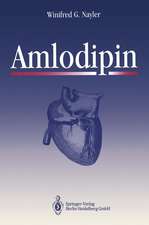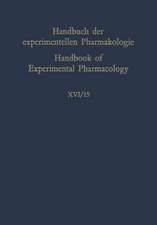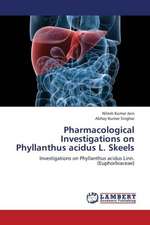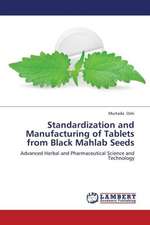Diuretics: Handbook of Experimental Pharmacology, cartea 117
Editat de Rainer F. Greger Contribuţii de O.S. Better Editat de H. Knauf Contribuţii de A. Busch Editat de E. Mutschler Contribuţii de J. Dorup, H. Endou, R. Greger, W.G. Guder, M. Hosoyamanda, M. Hropot, B. Kaissling, T.R. Kleymann, F. Lang, H.-J. Lang, W. Möhrke, T. Netzer, L.G. Palmer, J. B. Puschett, I. Rubinstein, M. Schmolke, F. Ullrich, K.J. Ullrich, H. Velazquez, J. Winaveren Limba Engleză Paperback – 10 dec 2011
Din seria Handbook of Experimental Pharmacology
- 5%
 Preț: 3517.78 lei
Preț: 3517.78 lei - 5%
 Preț: 1425.97 lei
Preț: 1425.97 lei - 5%
 Preț: 1435.28 lei
Preț: 1435.28 lei - 5%
 Preț: 1430.52 lei
Preț: 1430.52 lei - 5%
 Preț: 1930.69 lei
Preț: 1930.69 lei - 5%
 Preț: 1922.47 lei
Preț: 1922.47 lei - 5%
 Preț: 1937.46 lei
Preț: 1937.46 lei - 5%
 Preț: 2117.58 lei
Preț: 2117.58 lei - 5%
 Preț: 2119.96 lei
Preț: 2119.96 lei - 5%
 Preț: 2117.38 lei
Preț: 2117.38 lei - 5%
 Preț: 1088.17 lei
Preț: 1088.17 lei - 5%
 Preț: 1098.27 lei
Preț: 1098.27 lei - 5%
 Preț: 1420.29 lei
Preț: 1420.29 lei - 5%
 Preț: 1104.84 lei
Preț: 1104.84 lei - 5%
 Preț: 1104.84 lei
Preț: 1104.84 lei - 5%
 Preț: 1108.14 lei
Preț: 1108.14 lei - 5%
 Preț: 1106.69 lei
Preț: 1106.69 lei - 5%
 Preț: 1105.77 lei
Preț: 1105.77 lei - 5%
 Preț: 1174.35 lei
Preț: 1174.35 lei - 5%
 Preț: 1432.50 lei
Preț: 1432.50 lei - 5%
 Preț: 408.48 lei
Preț: 408.48 lei - 5%
 Preț: 409.63 lei
Preț: 409.63 lei - 5%
 Preț: 539.90 lei
Preț: 539.90 lei - 5%
 Preț: 720.47 lei
Preț: 720.47 lei - 5%
 Preț: 733.09 lei
Preț: 733.09 lei - 5%
 Preț: 731.27 lei
Preț: 731.27 lei - 5%
 Preț: 746.43 lei
Preț: 746.43 lei - 5%
 Preț: 747.72 lei
Preț: 747.72 lei - 5%
 Preț: 725.24 lei
Preț: 725.24 lei - 5%
 Preț: 742.80 lei
Preț: 742.80 lei - 5%
 Preț: 393.23 lei
Preț: 393.23 lei - 5%
 Preț: 735.66 lei
Preț: 735.66 lei - 5%
 Preț: 728.33 lei
Preț: 728.33 lei - 5%
 Preț: 389.52 lei
Preț: 389.52 lei - 5%
 Preț: 730.71 lei
Preț: 730.71 lei - 5%
 Preț: 740.58 lei
Preț: 740.58 lei - 5%
 Preț: 730.19 lei
Preț: 730.19 lei - 5%
 Preț: 723.42 lei
Preț: 723.42 lei - 5%
 Preț: 731.27 lei
Preț: 731.27 lei - 5%
 Preț: 726.68 lei
Preț: 726.68 lei - 5%
 Preț: 3516.49 lei
Preț: 3516.49 lei - 5%
 Preț: 737.11 lei
Preț: 737.11 lei - 5%
 Preț: 730.92 lei
Preț: 730.92 lei - 5%
 Preț: 738.78 lei
Preț: 738.78 lei - 5%
 Preț: 909.94 lei
Preț: 909.94 lei - 5%
 Preț: 720.10 lei
Preț: 720.10 lei - 5%
 Preț: 734.74 lei
Preț: 734.74 lei - 5%
 Preț: 727.80 lei
Preț: 727.80 lei
Preț: 729.26 lei
Preț vechi: 767.63 lei
-5% Nou
Puncte Express: 1094
Preț estimativ în valută:
139.55€ • 149.22$ • 116.35£
139.55€ • 149.22$ • 116.35£
Carte tipărită la comandă
Livrare economică 17 aprilie-01 mai
Preluare comenzi: 021 569.72.76
Specificații
ISBN-13: 9783642795671
ISBN-10: 3642795676
Pagini: 544
Ilustrații: XXI, 517 p.
Dimensiuni: 155 x 235 x 29 mm
Greutate: 0.75 kg
Ediția:Softcover reprint of the original 1st ed. 1995
Editura: Springer Berlin, Heidelberg
Colecția Springer
Seria Handbook of Experimental Pharmacology
Locul publicării:Berlin, Heidelberg, Germany
ISBN-10: 3642795676
Pagini: 544
Ilustrații: XXI, 517 p.
Dimensiuni: 155 x 235 x 29 mm
Greutate: 0.75 kg
Ediția:Softcover reprint of the original 1st ed. 1995
Editura: Springer Berlin, Heidelberg
Colecția Springer
Seria Handbook of Experimental Pharmacology
Locul publicării:Berlin, Heidelberg, Germany
Public țintă
Professional/practitionerCuprins
1 :Functional Anatomy of the Kidney.- A.Structural Organization of the Kidney.- B.General Organization of Renal Epithelia and Correlation with Transport.- C.Nephron and Collecting Duct Structure.- D.Alterations of Morphology in Electrolyte Disturbances.- References.- 2 : Basic Concepts of Renal Physiology.- A.Introduction.- B.Renal Blood Flow and Glomerular Filtration.- C.Renal Tubular Transport.- D.Regulation of Renal Water and Electrolyte Excretion.- References.- 3 : Renal Energy Metabolism.- A.Introduction.- B.Mechanisms of Renal ATP Formation.- C.Metabolic Substrates of Renal Energy Metabolism.- D.Regulation of ATP in Tubule Cells.- E.Interaction of Diuretic Substances with Renal Energy Metabolism.- References.- 4 : Discovery and Development of Diuretic Agents.- A.Introduction.- B.Xanthine Derivatives.- C.Osmotic Diuretics.- D.Mercurial Diuretics.- E.Carbonic Anhydrase Inhibitors.- F.Sulfonamide Diuretics.- G.Nonsulfonamide Diuretics.- H. So-called Polyvalent Diuretics.- I. Aquaretics.- J. New Aspects: Ion Transport Modulators.- References.- 5 :Metabolism of Diuretics.- A.Introduction.- B.Biotransformation.- C.Patterns of Biotransformation.- D.Biotransformation of Diuretics.- References.- 6 :Interaction of Diuretics with Transport Systems in the Proximal Renal Tubule.- A.Introduction.- B.Transport System for Hydrophobic Organic Anions (pflra-Aminohippurate).- C.Transport Systems for Organic Cations.- D.Transport Systems for Sulfate.- E.Transport Systems for Dicarboxylates.- F.Interaction of Diuretics with the Different Proximal Transport Systems.- G.How Does Metabolic Transformation Change the Interaction with the Transport Systems for Organic Anions and Cations?.- References.- 7 :Loop Diuretics.- A.Introduction.- B.The Heterogeneous Group of Loop Diuretics.- C.Organotropy of Loop Diuretics.- D.Saluretic and Diuretic Effects of Loop Diuretics and Cellular Mechanisms.- E.Effects of Loop Diuretics in the Intact Kidney.- G.Pharmacokinetics.- H. Pharmacokinetics and Pharmacodynamics.- I. Clinical Uses.- J. Adverse Effects.- References.- 8 :Thiazide Diuretics.- A.Introduction.- B.Chemical Structures.- C.Pharmacokinetics.- D.Pharmacodynamics.- E.Pharmacokinetics in Disease States.- F.Saluretic Effects of Thiazides.- G.Diuretics in Nonedematous States.- H. Side Effects of Diuretic Therapy.- I. Drug Combinations.- References.- 9 :Potassium-Retaining Diuretics: Aldosterone Antagonists.- A. Chemical Structure and Properties, Structure-Activity Relationships of Aldosterone Antagonists.- B.Pharmacodynamics.- C.Pharmacokinetics.- D.Therapeutic Use (Indications, Dosage, Contraindications).- E.Side Effects and Toxicology.- F. Drug Interactions.- References.- 10 :Potassium-Retaining Diuretics: Amiloride.- A.Introduction.- B.Structure-Function Relationships.- C.Pharmacodynamics.- D.Pharmacokinetics.- E.Therapeutic Use.- F.Side Effects and Toxicity.- G. Drug Interactions.- References.- 11 :Potassium-Retaining Diuretics: Triamterene.- A.Chemical Structure and Properties.- B.Pharmacodynamics.- C.Pharmacokinetics.- D.Therapeutic Use.- I. Indications.- II. Dosage.- III. Side Effects.- IV. Contraindications.- V. Drug Interactions.- E.Toxicity.- References.- 12 :Osmotic Diuretics: Mannitol.- A.Introduction.- B.Renal Effects.- IV. Transport of Other Ions.- V. Urinary Concentration and Dilution.- VI. Miscellaneous Effects.- C.Beneficial Extrarenal Effects of Hypertonic Mannitol.- D.Effects on the Cardiovascular System.- E.Clinical Use.- References.- 13 :Clinical Uses of Diuretics.- A.Introduction.- B.Physiological Basis of Diuretic Action and Clinical Implications of Physiological Principles.- C.Diuretics in the Treatment of Edematous States and Disorders Associated with Abnormalities of Renal Function.- D.Diuretics in the Treatment of Nonedematous Disorders.- E. Diuretic Side Effects and Adverse Reactions.- References.
























